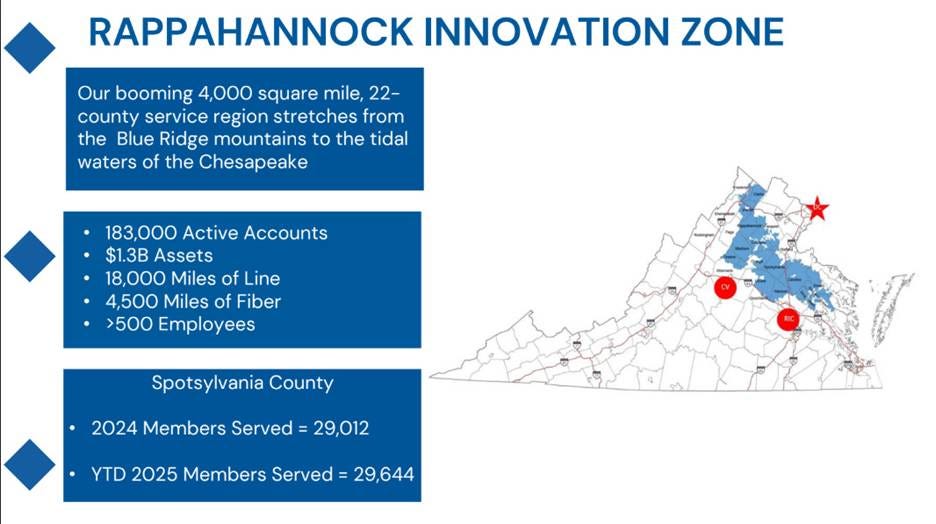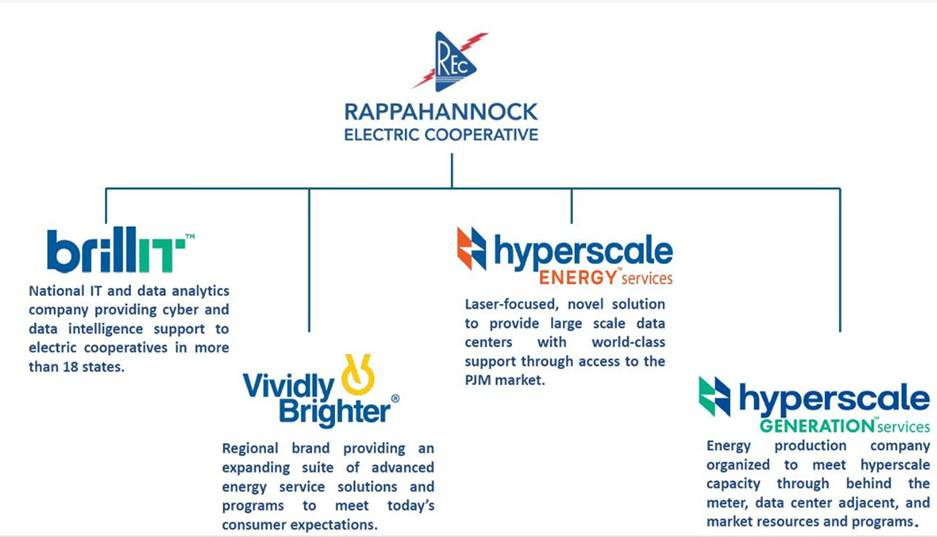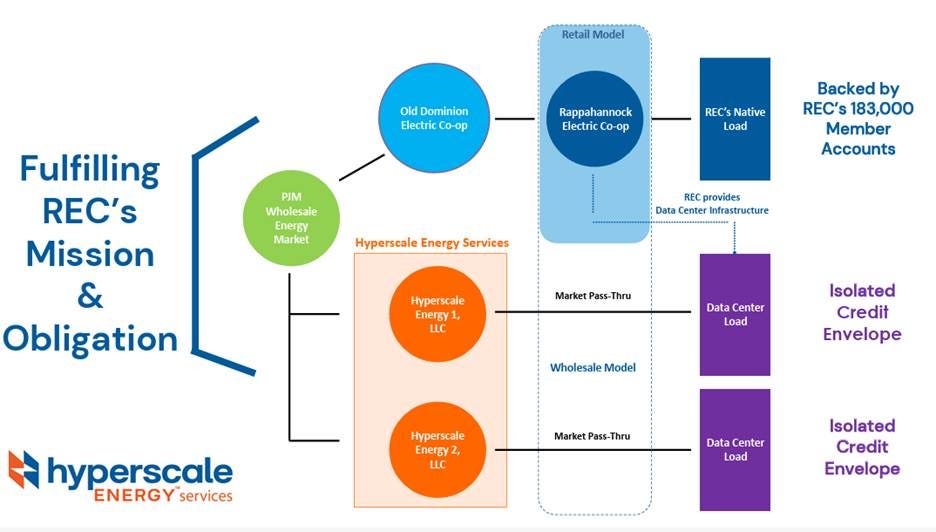DIGITAL INSIGHTS: Energy, Data Centers, and Everyday Consumers
Data centers present unique energy challenges that play out on two levels – local and national. REC is in the vanguard of addressing the local challenges.
By Martin Davis
EDITOR-IN-CHIEF
Email Martin

Digital Insights is a weekly feature usually appearing on Thursdays that explores the role of data centers in our region. These columns will focus on four areas: tracking the development of data centers in our area, exploring projected and actual tax revenue trends, explaining what data centers are and how they affect our daily lives, and reporting on research and emerging trends in the industry. These columns are made possible, in part, by a grant from Stack Infrastructure.
As data centers continue to rise across the commonwealth and the nation, the challenges associated with powering them are becoming more acute. Though estimates vary, there is broad agreement that demand is rising exponentially.
Deloitte, for example, projects that “By 2035, … power demand from AI data centers in the United States could grow more than thirtyfold, reaching 123 gigawatts, up from 4 gigawatts in 2024.”
Addressing this challenge is something that will be done on multiple levels. For the average homeowner or renter, however, concerns over the amount of energy data centers consume generate a more foundational question.
Will my access to energy be constrained?
It’s not just a question of convenience. The devices and services that people depend on — smartphones, navigation tools, banking services, healthcare delivery — require data centers. And dependable power delivery to homes is necessary to power the devices that allow people to access our increasingly digital and electrified world.
As data centers rise here in the Diamond region, how will local energy suppliers ensure that home energy supply is not disrupted because of increasing load demands from data centers?
The answer is found on two levels — one national, one local.
Old Tools Won’t Solve New Problems
Ultimately, the question of total power generation is a problem that will be addressed on the national level. As Deloitte explains, “At the same time as data centers are pushing up peak demand, baseload generation is contracting, while new generation projects are stuck in increasingly long interconnection queues, 95% of which consist of renewables and storage.”
That pressure falls on regional transmission organizations like PJM, which serves 13 states (including Virginia) and D.C. and coordinates the buying and selling of energy so that demand is met. Currently, PJM is implementing a Critical Issue Fast Path (CIFP) decision-making process to address the growing demand of data centers in the PJM market.
However, ensuring power delivery to homes and businesses — including data centers — is a local challenge for providers like Rappahannock Electric Cooperative (REC).
Over the past several years, REC Chief Executive Officer John Hewa and his team have created innovative new business models to manage the growing demand for power created by data centers, while protecting so-called traditional customers like homes, schools, and businesses.
Understanding the Challenge
The REC is a nonprofit, member-owned co-op which is required by state law to serve its members. Currently, that includes 183,000 homes and businesses over 22 counties and some 4,000 square miles.
To put into perspective the challenge REC faces with data centers coming online, Hewa noted that on the coldest day this past January, REC’s 183,000 accounts achieved an all-time energy peak — 1,150 megawatts (MW).
Within REC’s footprint, however, there is about 20,000 MW of inbound data center load ramp requests. In other words, data center companies have signaled that they plan to build and will require this amount of energy to operate. “Not all of these requests will become reality,” Hewa said, but this figure gives some understanding of just how much more energy REC is going to have deliver in the coming years.
Meeting this demand means managing risk. REC must protect its traditional customers, while simultaneously building for growing demand.
Hewa said this means meeting two separate challenges. On one side is infrastructure. This includes the poles, wires, and substations that deliver energy. The costs associated with this represent about 35% of REC’s budget.
On the other side are energy and electrons. This represents about “64% of our costs,” Hewa said.
On the infrastructure side, REC is meeting that challenge “in a very traditional way,” Hewa said. The Co-op owns, installs, and maintains that infrastructure. What is critical to note, however, is that this new data center infrastructure is being paid for entirely by the data center customers. This insulates traditional customers from the costs associated with building out and maintaining this infrastructure that is used just to serve the data centers.
On the energy side, REC now has a proposal before the State Corporation Commission whereby it will bill data center clients weekly for the energy that they project they will need, and require the data centers to post collateral to ensure they can pay their bills on time. This further insulates traditional customers from data center costs.
“At the local level,” Hewa said, “we are not intermixing data center loads with our normal grid. There is a strict differentiation.”
REC can split services this way because it has intentionally built new businesses under REC to manage this work.
Managing Risk
Preparing for the arrival of data center energy demand meant REC had to find ways to manage risks to its traditional customer base.
“Traditional risk management looks at impact and likelihood,” Hewa told the Advance. This includes the impact of the decisions REC makes on their customers, and the likelihood of what will happen given different future scenarios. “We’ve studied this intently,” he said. But, “we’ve now added velocity to our thinking.”
Adding velocity to its risk-management thinking is what led REC to a solution that keeps the two groups of customers — its traditional customers and very large load customers like data centers — separate.
The company accomplished this by creating a number of for-profit businesses to both grow revenue on the traditional side of the business, as well as deliver services to the data centers coming online.
Hyperscale Energy Services and Hyperscale Generation Services are designed specifically to service the data center industry.
When a data center comes online, it will be served through a Hyperscale Energy affiliate, while REC’s traditional customers continue to receive service through REC’s relationship with Old Dominion Electric Cooperative, which owns and operates power plants and makes energy purchases on the wholesale market.
“We did not want to assume or presume that REC should lean on its traditional members to get the job done,” Hewa told the Advance. “Hyperscale puts data centers in their own bucket. So we get a pure solution.”
In short, traditional customers are not bearing the costs associated with REC having to service data centers.
The data centers are paying for all the infrastructure to come online, they will be paying REC upfront for the energy they anticipate consuming, and they function under a separate for-profit umbrella set up by REC to further ensure that data centers and traditional customers stay separate.
Transmission
The solution that REC has constructed is designed to protect traditional customers while onboarding new data centers. That is a local challenge.
What it can’t address is the problems associated with having to buy energy and get it delivered over the transmission grid managed by PJM.
“The bulk of the inflation [in energy costs] is in the market,” Hewa told the Advance. “It’s not local. Data centers are providing the land, prepaying for the infrastructure, and providing lines of credits to back up the projects.”
A significant reason that PJM wholesale energy and transmission prices are climbing is that Virginia has not been building new, dispatchable energy generation. (A dispatchable energy source can be called on whenever needed, unlike wind and solar facilities which operate intermittently.) And Dominion Energy is facing an increasing number of requests to connect to the grid, which typically requires transmission system upgrades.
“Virginia is now the top importer of energy in the country,” Hewa noted. It used to be California.
“Virginia has been leaning on adjacent states because our energy generation policies are strict on carbon emissions,” Hewa said. What’s driving the rise in wholesale energy prices is a surge in demand coupled with no new dispatchable generation here in Virginia. “Until Virginia and PJM right-size their energy sources, energy prices are going to rise, sometimes significantly.”
Unfortunately, these challenges are beyond REC’s control. However, PJM is aggressively attacking the problem.
On August 8 2025, the PJM Board of Managers announced it was looking to use Critical Issue Fast Pass (CIFP) as a way to speed up the discovery of energy solutions for new large loads like data centers.
CIFP is “an accelerated decision-making method available to the Board and PJM stakeholders to advance matters more expeditiously through the stakeholder process,” according to PJM Inside Lines.
PJM has also announced that it will realize an addition of 11,000 MW of generation “within the next 18 months, and [it] expects to see additional generation added to the system through its reform efforts, including expansion of surplus interconnection service to utilize the unused portion of interconnection service for facilities that do not operate continuously (such as adding battery storage to a solar generator).”
Bold Future
REC’s approach to insulating traditional consumers from data center onboarding is a distinctive model that is attracting attention from other cooperatives across the country, and may prove useful in helping local electric companies face the challenges they see in onloading data centers.
The transmission and generation challenges are real, but PJM is already working toward solutions that will strengthen the grid in quicker ways.
The challenges being created by data centers on energy draw are significant, but so, too, notes Hewa, are the benefits they bring.
“Data centers have provided extensive public benefits - lot of success stories helping Virginia and the greater service that’s happening globally because Virginia is the anchor.”
Data centers and AI are creating a bold new future. What’s certain, Hewa said, is that “old tools won’t solve new problems.”
REC sits in the vanguard of developing the tools for tomorrow’s energy challenges.
Local Obituaries
To view local obituaries or to send a note to family and loved ones, please visit the link that follows.
Support Award-winning, Locally Focused Journalism
The FXBG Advance cuts through the talking points to deliver both incisive and informative news about the issues, people, and organizations that daily affect your life. And we do it in a multi-partisan format that has no equal in this region. Over the past year, our reporting was:
First to break the story of Stafford Board of Supervisors dismissing a citizen library board member for “misconduct,” without informing the citizen or explaining what the person allegedly did wrong.
First to explain falling water levels in the Rappahannock Canal.
First to detail controversial traffic numbers submitted by Stafford staff on the Buc-ee’s project
Our media group also offers the most-extensive election coverage in the region and regular columnists like:
And our newsroom is led by the most-experienced and most-awarded journalists in the region — Adele Uphaus (Managing Editor and multiple VPA award-winner) and Martin Davis (Editor-in-Chief, 2022 Opinion Writer of the Year in Virginia and more than 25 years reporting from around the country and the world).
For just $8 a month, you can help support top-flight journalism that puts people over policies.
Your contributions 100% support our journalists.
Help us as we continue to grow!
This article is published under Creative Commons license CC BY-NC-ND. It can be distributed for noncommercial purposes and must include the following: “Published with permission by FXBG Advance.”
















When and why did you become a shill for the Data Center industry? Stack are the people who bribed City Council to pass the re-zoning
Seriously? You're running stories sponsored by a data center company now?